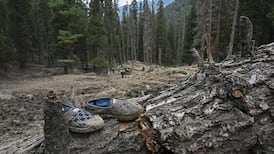Japan issued evacuation advisories for more than a million people and cancelled hundreds of flights as Typhoon Jebi sliced across the west on Tuesday, cutting power, overturning cars and killing at least six people.
Jebi, or “swallow” in Korean, was briefly a super typhoon and is the most powerful storm to hit Japan in 25 years following rains, landslides, floods and record-breaking heat that killed hundreds of people this summer.
Television footage showed waves pounding the coastline, sheet metal tumbling across a parking lot, cars turned on their sides, dozens of used cars on fire at an exhibition area, and a big Ferris wheel spinning around in the strong wind.
0 of 3
As the typhoon made landfall, a 71-year-old man was found dead under a collapsed warehouse, likely due to a strong wind, and a man in his 70s fell from the roof of a house and died, NHK public television reported, adding more than 90 were injured.
NHK and broadcaster TBS put the number of deaths at six.
Tides in some areas were the highest since a typhoon in 1961, NHK said, with flooding covering one runway at Kansai airport near Osaka, forcing the closure of the airport and leaving about 3,000 tourists stranded.
“This storm is super [strong]. I hope I can get home,” a woman from Hong Kong told NHK at the airport.
The strong winds and high tides sent a 2,591-tonne tanker crashing into a bridge connecting the airport, built on a man-made island in a bay, to the mainland. The bridge was damaged and closed, but the tanker was empty and none of its crew was injured, the coast guard said.
The storm made landfall on Shikoku, the smallest main island, around noon. It raked across the western part of the largest main island, Honshu, near the city of Kobe, several hours later, before heading into the Sea of Japan in the evening.
The centre of Jebi was about 100km west-northwest of Sado in Niigata prefecture, central Japan, and heading north-northeast, NHK said.
Evacuation advisories were issued for more than a million people at one point, the Fire and Disaster Management Agency said. Wind gusts of up to 208 km/h (129 mph) were recorded in one part of Shikoku.
Around 100mm (3.9in) of rain drenched one part of the tourist city of Kyoto in an hour, with as much as 500mm (20in) set to fall in some areas in the 24 hours to noon on Wednesday.
Video posted on Twitter showed a small part of the roof of Kyoto train station falling to the ground. Other video showed roofs being torn off houses, transformers on electric poles exploding and a car scudding on its side across a car park.
Nearly 800 flights were cancelled, along with scores of ferries and trains, NHK said. Shinkansen bullet train services between Tokyo and Okayama were suspended and Universal Studios Japan, a popular amusement park near Osaka, was closed.
Some 1.6 million households were without power in Osaka and its surrounding areas at 5pm (7am Irish time) Toyota Motor Corp said it was cancelling the night shift at 14 plants.
The capital, Tokyo, escaped the centre of the storm but was set for heavy rains and high winds.
Jebi’s course brought it close to parts of western Japan hit by rains and flooding that killed more than 200 people in July but most of the damage this time appeared to be from the wind. – Reuters















